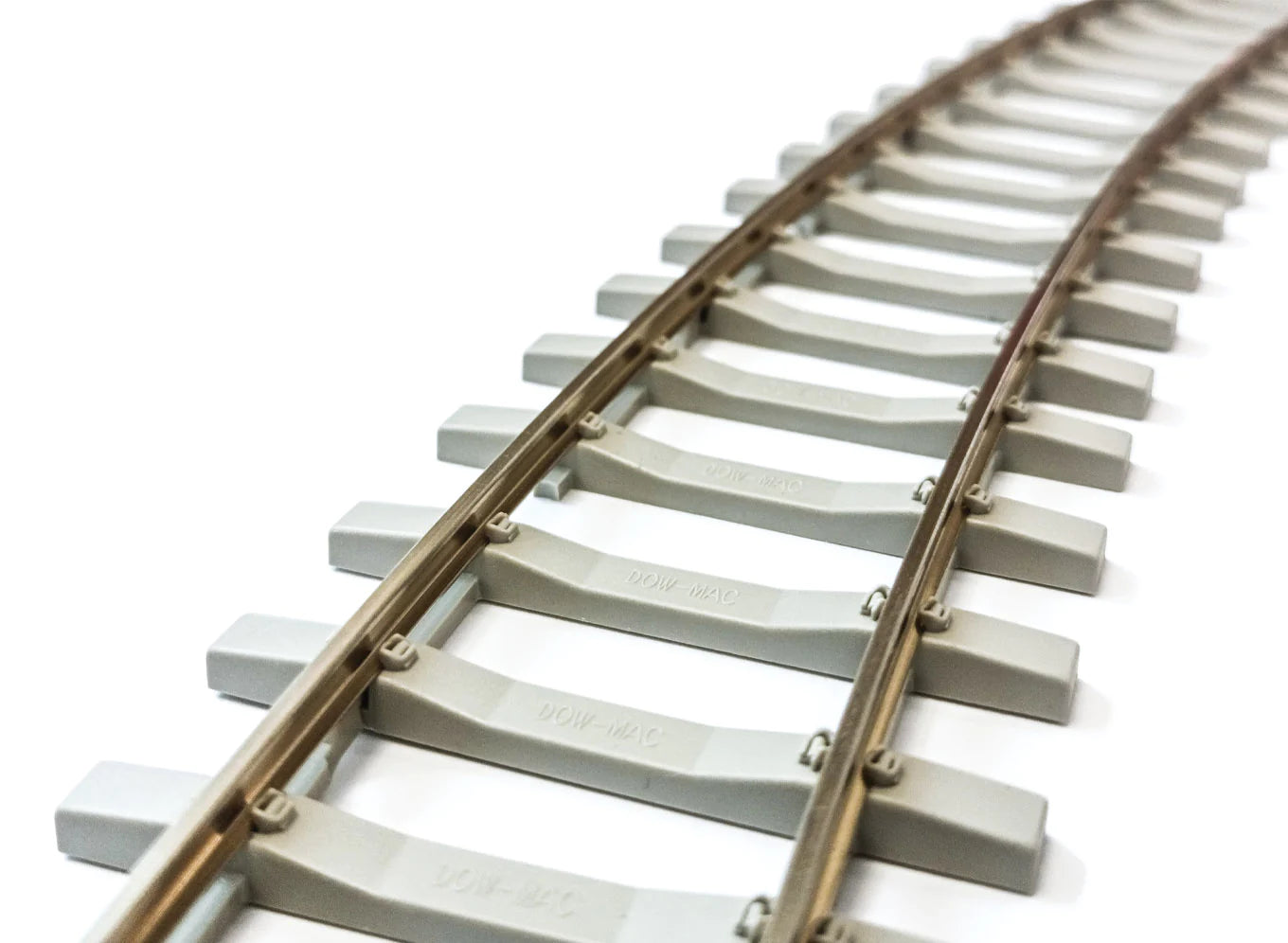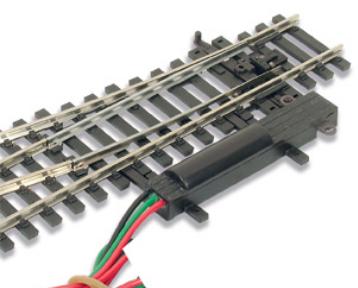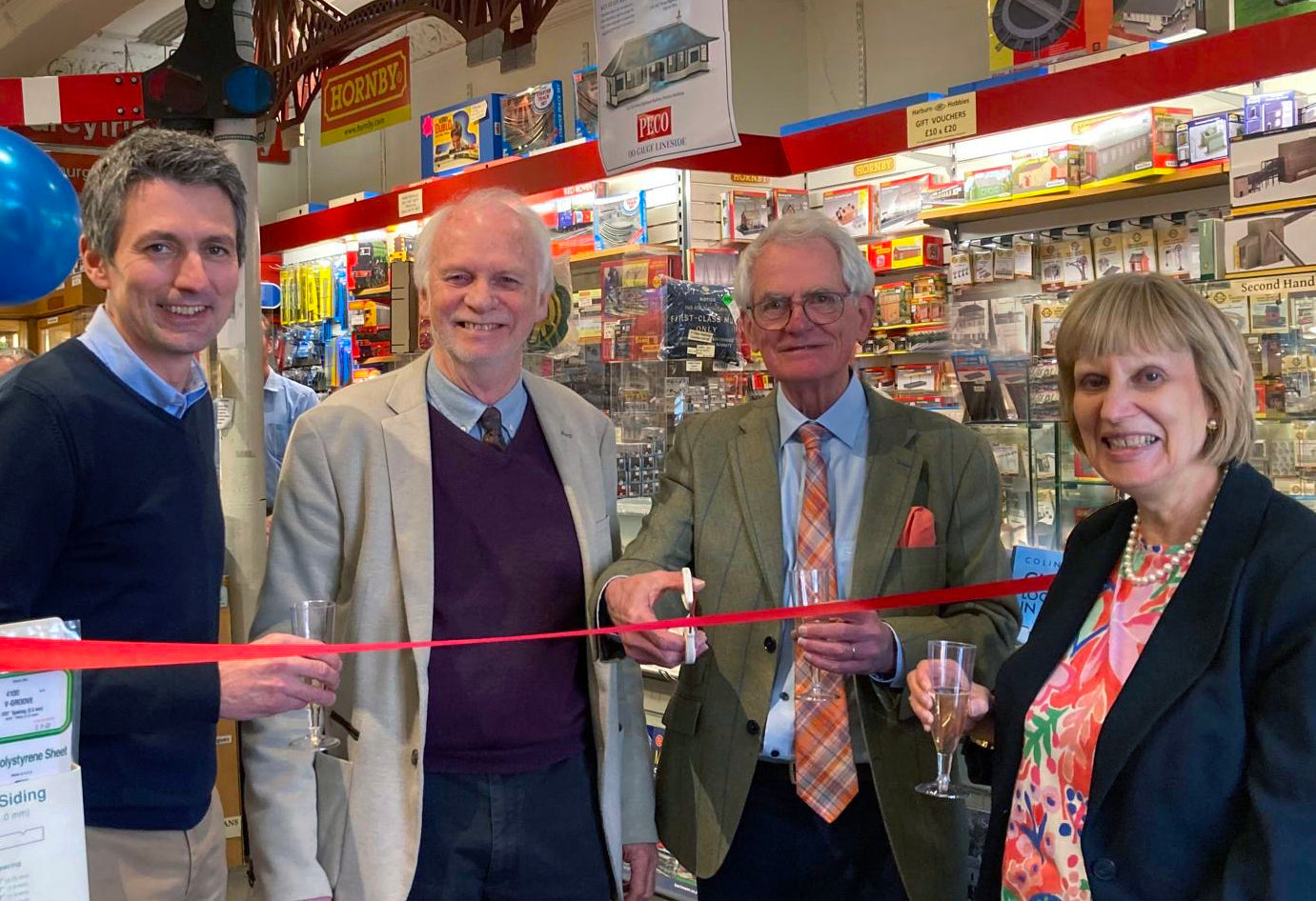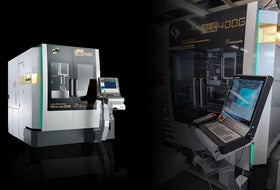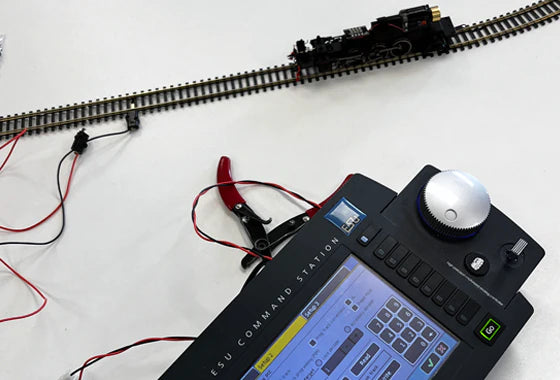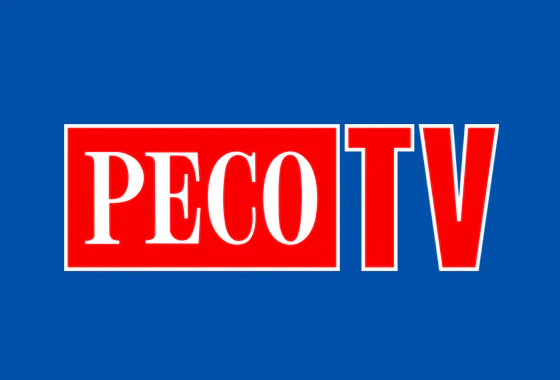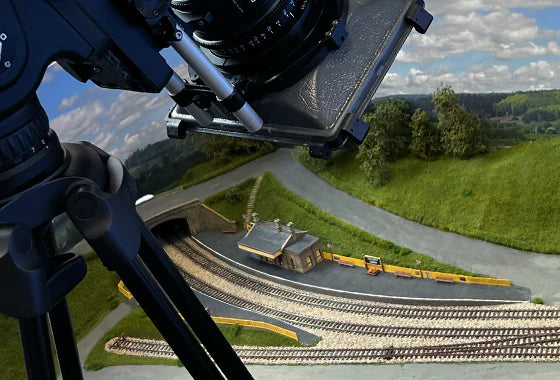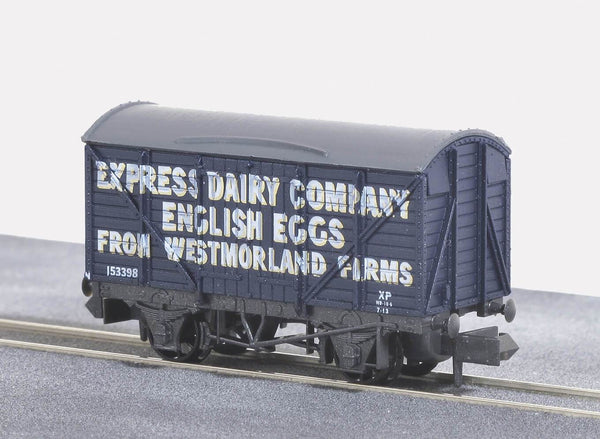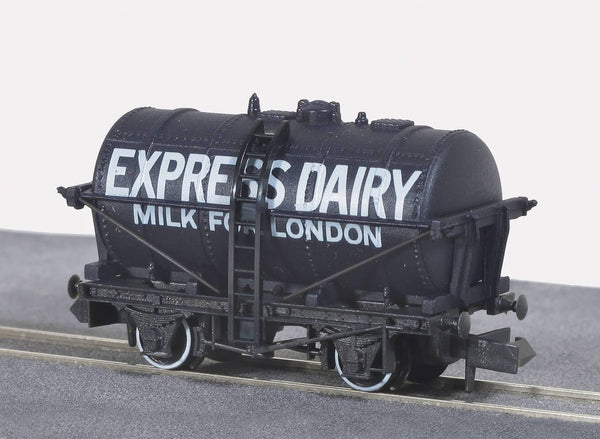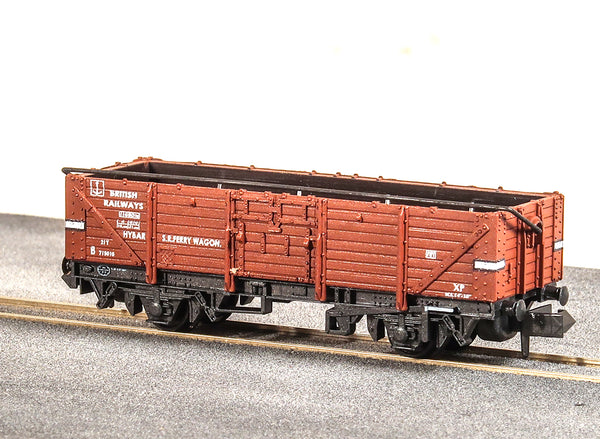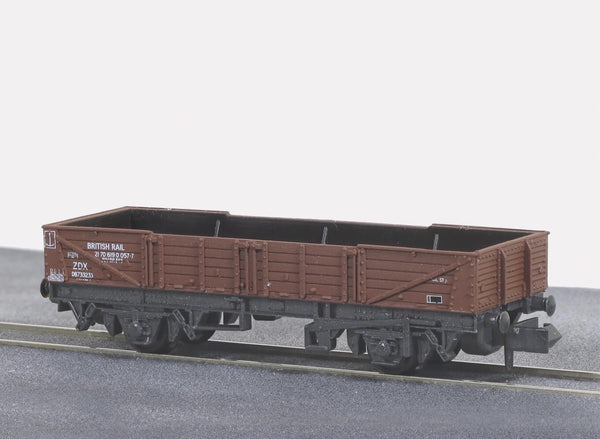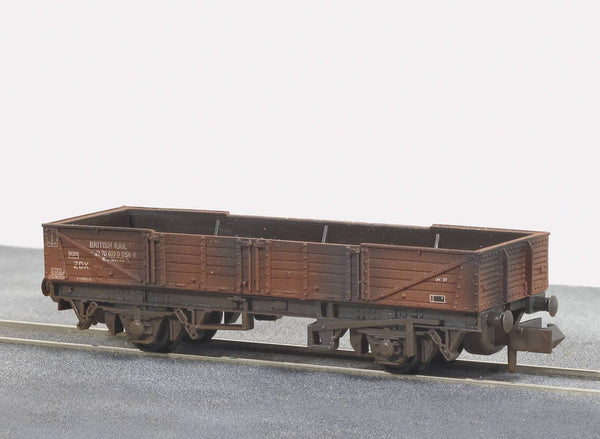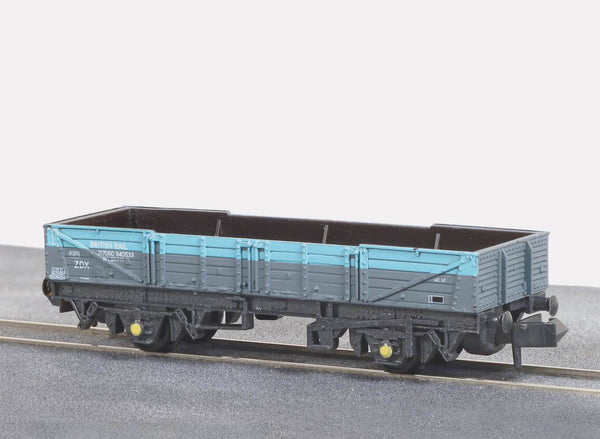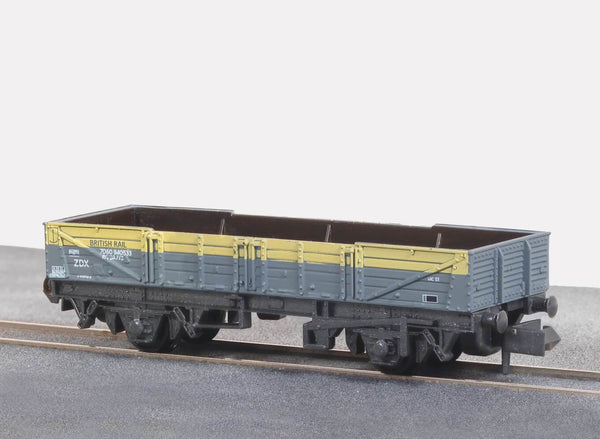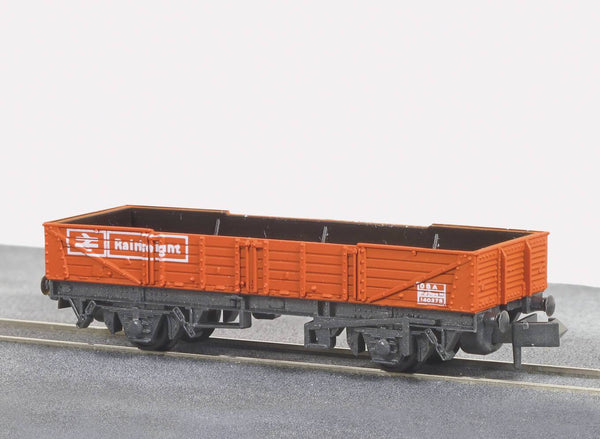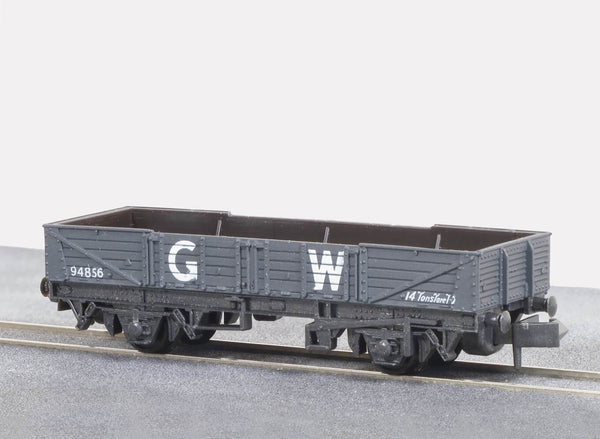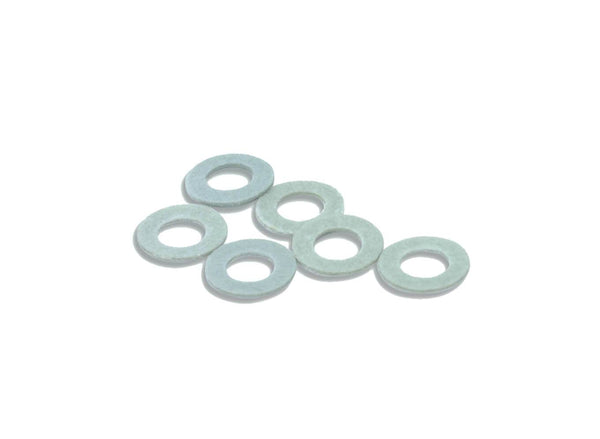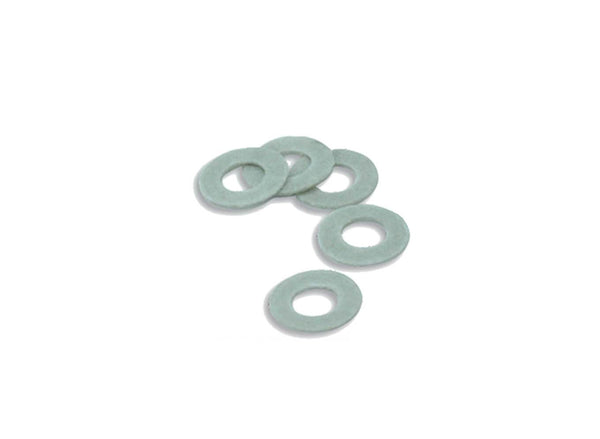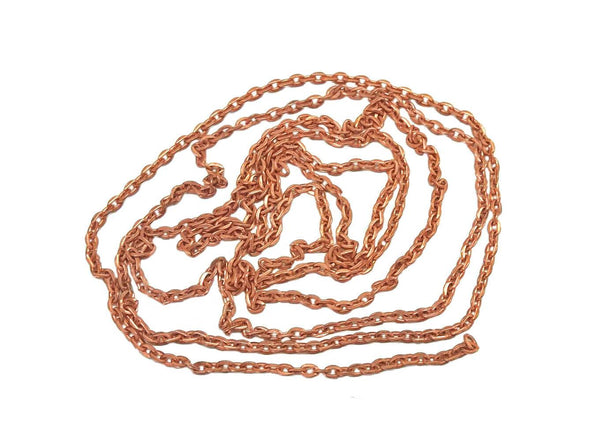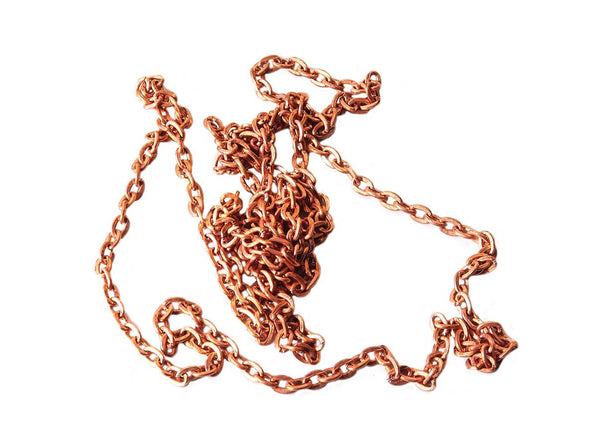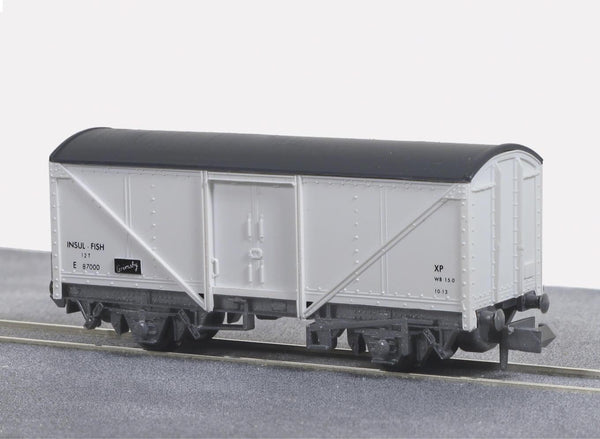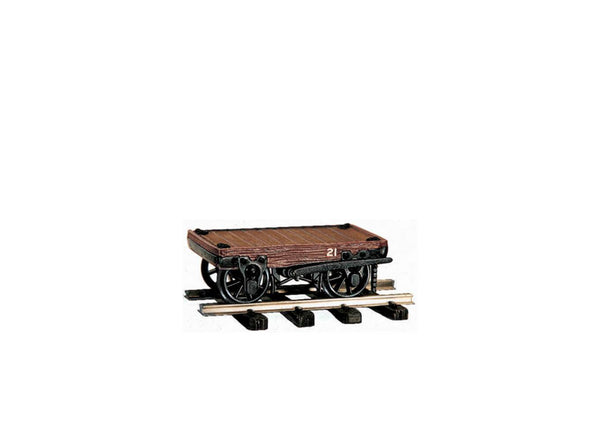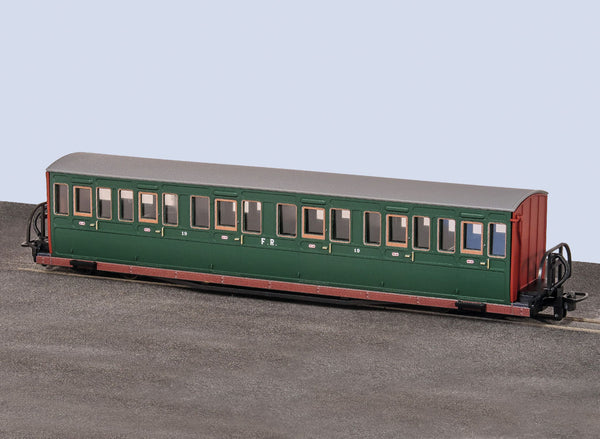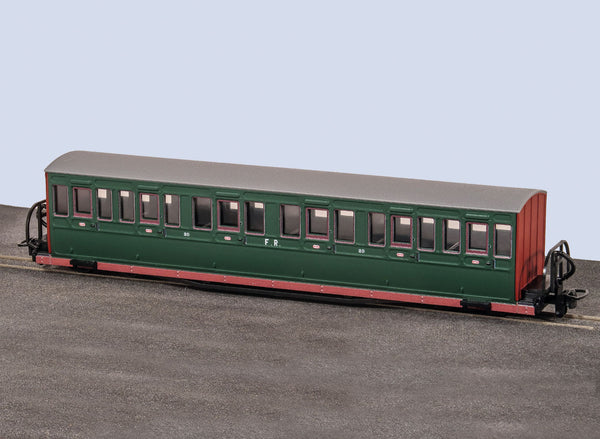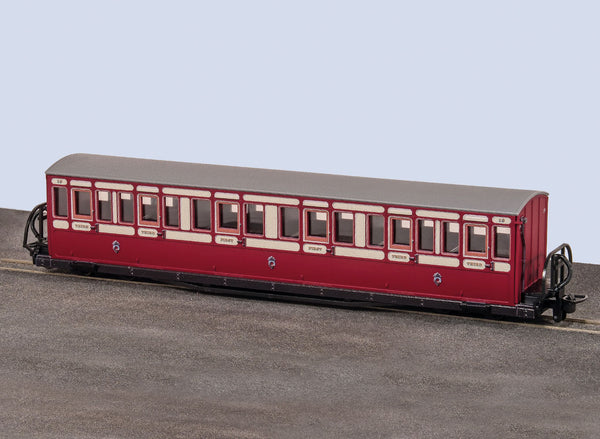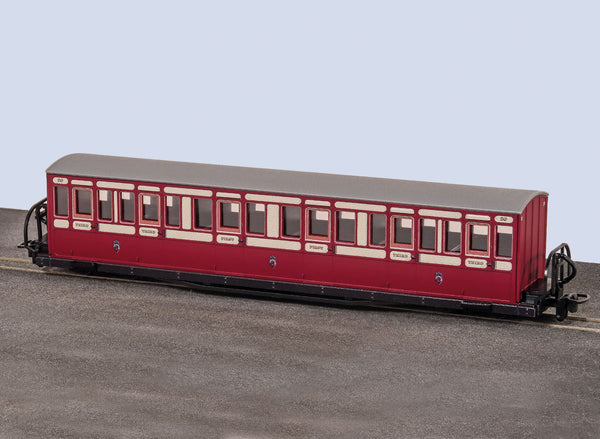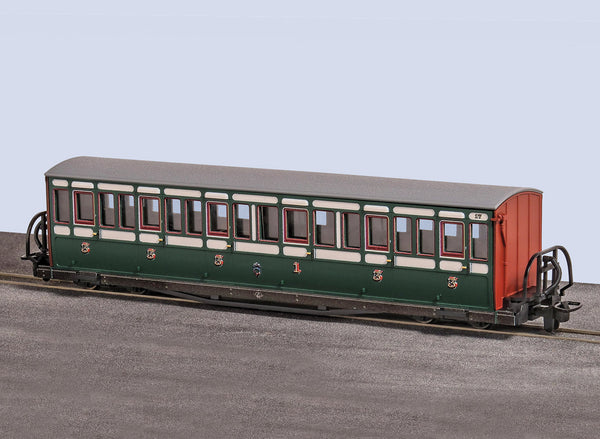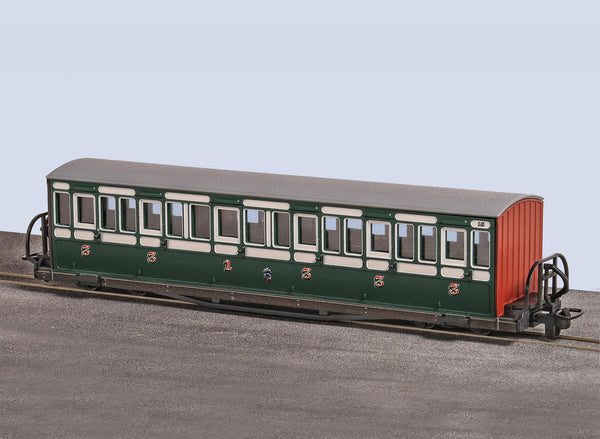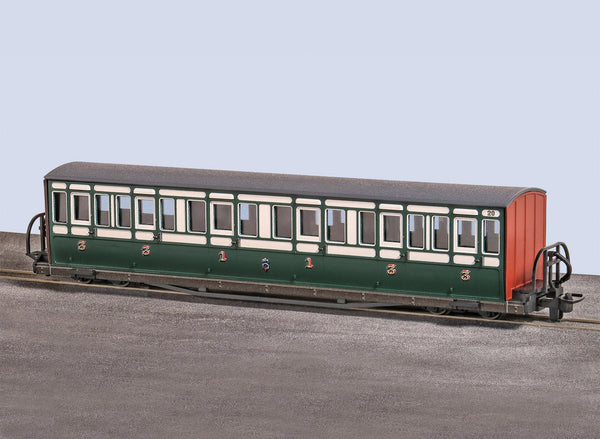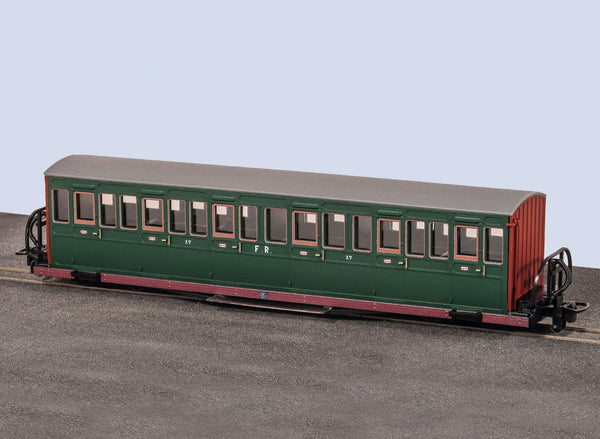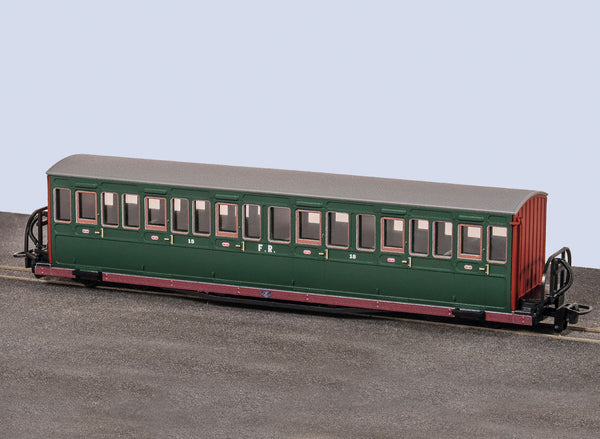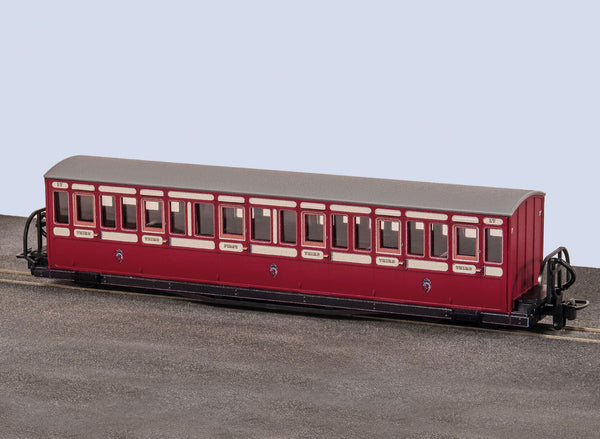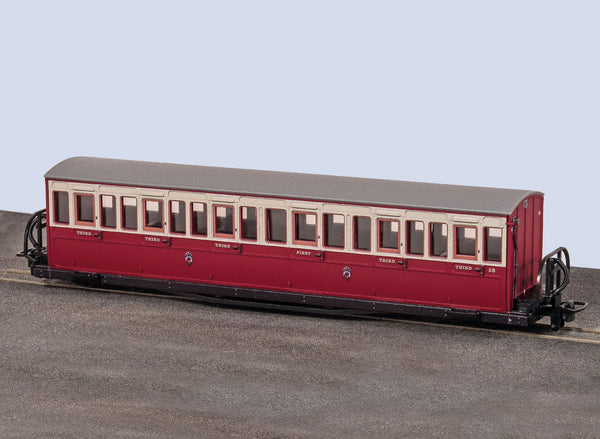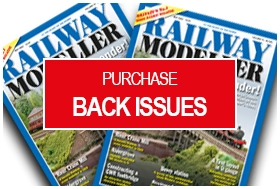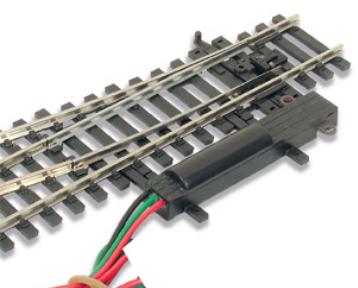BROWSE PECO PRODUCTS
Browse through our complete product portfolio.
740 Products Found
Ex-BR 16t Mineral Wagon, NCB
All-New Tooling Wagons
Once common on the post-war British Railway network, these 4-wheel vans carried a wide variety of goods throughout the system. No longer in service they remain an iconic wagon type so typical of the railway scene from the 1950s to the 1980s and modellers will find a home for several on their layouts.
The bauxite version of this wagon represents a slightly later period in the wagons life, whilst the black NCB version represents the wagons it it appeared once sold-on for internal use at various coal mine sites.
All of the new-tooling ready-to-run wagons from PECO feature some very fine moulding detail, sharp and precise application of the liveries, detachable couplers and metal-tyred running wheels. Best of all, they are the best value on the market compared to the alternatives available!
Ex-BR Iron Ore Tippler, NCB
All-New Tooling Wagons
Once common on the post-war British Railway network, these 4-wheel vans carried a wide variety of goods throughout the system. No longer in service they remain an iconic wagon type so typical of the railway scene from the 1950s to the 1980s and modellers will find a home for several on their layouts.
The bauxite version of this wagon represents a slightly later period in the wagons life, whilst the black NCB version represents the wagons it it appeared once sold-on for internal use at various coal mine sites.
All of the new-tooling ready-to-run wagons from PECO feature some very fine moulding detail, sharp and precise application of the liveries, detachable couplers and metal-tyred running wheels. Best of all, they are the best value on the market compared to the alternatives available!
Express Dairy English Eggs Box Van
Private owner wagons abounded prior to nationalisation, they would often be seen far from their base as they were sent to collect raw materials and supplies such as coal, and deliver finished goods. All Peco wagons feature free running wheels in pin point axles. The ELC coupling, whilst compatible with the standard N gauge couplings, keeps a realistic distance between vehicles and enables the PL-25 electro magnetic decoupler to be used for remote uncoupling.
Express Dairy Milk Tank Wagon
Private owner wagons abounded prior to nationalisation, they would often be seen far from their base as they were sent to collect raw materials and supplies such as coal, and deliver finished goods. All Peco wagons feature free running wheels in pin point axles. The ELC coupling, whilst compatible with the standard N gauge couplings, keeps a realistic distance between vehicles and enables the PL-25 electro magnetic decoupler to be used for remote uncoupling.
Ferry Open Wagon BR 'Hybar'
Built in 1957, this small fleet of open wagons were design specifically for the movement of consignments to and from the continent by the channel train ferry. Allocated to the Southern Region, they featured an adjustable bar that supported a tarpaulin. On our model the bar is included, and can be removed as required, as was done on the real wagons when they were eventually used for internal traffic. Our model faithfully replicates the bauxite livery and all the various markings as per the prototype, including the corner flashes in black and white. All Peco wagons feature free running wheels in pin point axles. The ELC coupling, whilst compatible with the standard N gauge couplings, keeps a realistic distance between the vehicles and enables the PL-25 electro magnetic decoupler to be used for remote uncoupling.
Ferry Tube Wagon
Railway companies all had a stock of their own vehicles for carrying goods and merchandise around their network, and also onto other companies' routes as and when required. These were integrated into British Railways at Nationalisation; some of them to be once more re liveried under sectorisation as the network was prepared to be returned to private ownership. All Peco wagons feature free running wheels in pin point axles. The ELC coupling, whilst compatible with the standard N gauge couplings, keeps a realistic distance between the vehicles and enables the PL-25 electro magnetic decoupler to be used for remote uncoupling.
Ferry Tube Wagon
Railway companies all had a stock of their own vehicles for carrying goods and merchandise around their network, and also onto other companies' routes as and when required. These were integrated into British Railways at Nationalisation; some of them to be once more re liveried under sectorisation as the network was prepared to be returned to private ownership. All Peco wagons feature free running wheels in pin point axles. The ELC coupling, whilst compatible with the standard N gauge couplings, keeps a realistic distance between the vehicles and enables the PL-25 electro magnetic decoupler to be used for remote uncoupling.
Ferry Tube Wagon
Railway companies all had a stock of their own vehicles for carrying goods and merchandise around their network, and also onto other companies' routes as and when required. These were integrated into British Railways at Nationalisation; some of them to be once more re liveried under sectorisation as the network was prepared to be returned to private ownership. All Peco wagons feature free running wheels in pin point axles. The ELC coupling, whilst compatible with the standard N gauge couplings, keeps a realistic distance between the vehicles and enables the PL-25 electro magnetic decoupler to be used for remote uncoupling.
Ferry Tube Wagon
Railway companies all had a stock of their own vehicles for carrying goods and merchandise around their network, and also onto other companies' routes as and when required. These were integrated into British Railways at Nationalisation; some of them to be once more re liveried under sectorisation as the network was prepared to be returned to private ownership. All Peco wagons feature free running wheels in pin point axles. The ELC coupling, whilst compatible with the standard N gauge couplings, keeps a realistic distance between the vehicles and enables the PL-25 electro magnetic decoupler to be used for remote uncoupling.
Ferry Tube Wagon
Railway companies all had a stock of their own vehicles for carrying goods and merchandise around their network, and also onto other companies' routes as and when required. These were integrated into British Railways at Nationalisation; some of them to be once more re liveried under sectorisation as the network was prepared to be returned to private ownership. All Peco wagons feature free running wheels in pin point axles. The ELC coupling, whilst compatible with the standard N gauge couplings, keeps a realistic distance between the vehicles and enables the PL-25 electro magnetic decoupler to be used for remote uncoupling.
Ferry Tube Wagon
Railway companies all had a stock of their own vehicles for carrying goods and merchandise around their network, and also onto other companies' routes as and when required. These were integrated into British Railways at Nationalisation; some of them to be once more re liveried under sectorisation as the network was prepared to be returned to private ownership. All Peco wagons feature free running wheels in pin point axles. The ELC coupling, whilst compatible with the standard N gauge couplings, keeps a realistic distance between the vehicles and enables the PL-25 electro magnetic decoupler to be used for remote uncoupling.
Ferry Tube Wagon
Railway companies all had a stock of their own vehicles for carrying goods and merchandise around their network, and also onto other companies' routes as and when required. These were integrated into British Railways at Nationalisation; some of them to be once more re liveried under sectorisation as the network was prepared to be returned to private ownership. All Peco wagons feature free running wheels in pin point axles. The ELC coupling, whilst compatible with the standard N gauge couplings, keeps a realistic distance between the vehicles and enables the PL-25 electro magnetic decoupler to be used for remote uncoupling.
Ffestiniog and Blaenau Rly 4 Wheel 1st/2nd Class Coach
These finely moulded plastic wagon kits come complete with pin point axle wheels. Glue and paint will be required, along with appropriate transfers.
Ffestiniog and Blaenau Rly 4 Wheel 3rd Class Coach
These finely moulded plastic wagon kits come complete with pin point axle wheels. Glue and paint will be required, along with appropriate transfers.
Ffestiniog and Blaenau Scorcher/Nipper
Locomotive body kit which will require a motor and chassis, glue, paint and transfers to complete.
Ffestiniog and Blaneau Rly 4 Comp Panelled Composite Coach
These finely moulded plastic wagon kits come complete with pin point axle wheels. Glue and paint will be required, along with appropriate transfers.
Ffestiniog and Blaneau Rly Planked 4 Wheel 1st/2nd Class Coach
These finely moulded plastic wagon kits come complete with pin point axle wheels. Glue and paint will be required, along with appropriate transfers.
Ffestiniog and Blaneau Rly Planked 4 Wheel 3rd Class Coach
These finely moulded plastic wagon kits come complete with pin point axle wheels. Glue and paint will be required, along with appropriate transfers.
Ffestiniog Rly 2ton Steel Sided Slate Wagon
These finely moulded plastic wagon kits come complete with pin point axle wheels. Glue and paint will be required, along with appropriate transfers.
Ffestiniog Rly 4 Wheel Hudson Steel Bodied Open Wagon
These finely moulded plastic wagon kits come complete with pin point axle wheels. Glue and paint will be required, along with appropriate transfers.
Ffestiniog Rly Bogie Coach
These finely moulded plastic wagon kits come complete with pin point axle wheels. Glue and paint will be required, along with appropriate transfers.
Ffestiniog Rly Bogie Luggage Van
These finely moulded plastic wagon kits come complete with pin point axle wheels. Glue and paint will be required, along with appropriate transfers.
Ffestiniog Rly Goods Brake Van
These finely moulded plastic wagon kits come complete with pin point axle wheels. Glue and paint will be required, along with appropriate transfers.
Ffestiniog Rly Granite Wagon
These finely moulded plastic wagon kits come complete with pin point axle wheels. Glue and paint will be required, along with appropriate transfers.
Ffestiniog Rly Granite Wagons
These finely moulded plastic wagon kits come complete with pin point axle wheels. Glue and paint will be required, along with appropriate transfers.
Ffestiniog Rly Semi Open Bogie Coach
These finely moulded plastic wagon kits come complete with pin point axle wheels. Glue and paint will be required, along with appropriate transfers.
Ffestiniog Rly Slate Wagon
These finely moulded plastic wagon kits come complete with pin point axle wheels. Glue and paint will be required, along with appropriate transfers.
Ffestiniog Rly Slate Wagon
These finely moulded plastic wagon kits come complete with pin point axle wheels. Glue and paint will be required, along with appropriate transfers.
Ffestiniog Rly Standard Bogie Coach
These finely moulded plastic wagon kits come complete with pin point axle wheels. Glue and paint will be required, along with appropriate transfers.
Fine Chain 13 links per inch
Useful as a load or for securing loads, or for cranes, hoists etc.
Fine Chain 9 links per inch
Useful as a load or for securing loads, or for cranes, hoists etc.
Fish Van
Railway companies all had a stock of their own vehicles for carrying goods and merchandise around their network, and also onto other companies' routes as and when required. These were integrated into British Railways at Nationalisation; some of them to be once more re liveried under sectorisation as the network was prepared to be returned to private ownership. All Peco wagons feature free running wheels in pin point axles. The ELC coupling, whilst compatible with the standard N gauge couplings, keeps a realistic distance between the vehicles and enables the PL-25 electro magnetic decoupler to be used for remote uncoupling.
Flat Wagon 2 Ton
White Metal Kit of typical vehicle based on the Welsh narrow gauge stock from the heyday of the slate traffic era. (Couplings, paint and transfers not included).
FR Long 'Bowsider' Coach - Colonel Stephens No.19
The Ffestiniog Railway operated two pairs of bogie coaches numbered 17-20 and built by Brown Marshalls & Co and Gloucester Wagon Co. They were known as ‘Bowsiders’ because of the tumblehome shape of their sides. Numbers 17 and 18, built in 1876 are shorter with one 1st class compartment. Numbers 19 and 20, built in 1879 are longer with two 1st class compartments. All four are still in service on the Ffestiniog Railway today.
In the 1920s the elaborate liveries of the Victorian era were replaced with a simple scheme of green with red end panels. It became known as the ‘Colonel Stephens’ livery, after the General Manager of the Ffestiniog Railway from 1925 until his passing in 1931. The colour scheme was used until the end of passenger operations in 1939, sometimes alongside other colours such as yellow, in the mid 1930s.
Green with red ends was applied to carriage No.20 once again from 2005 until 2024, as depicted by GR-623B.
FR Long 'Bowsider' Coach - Colonel Stephens No.20
The Ffestiniog Railway operated two pairs of bogie coaches numbered 17-20 and built by Brown Marshalls & Co and Gloucester Wagon Co. They were known as ‘Bowsiders’ because of the tumblehome shape of their sides. Numbers 17 and 18, built in 1876 are shorter with one 1st class compartment. Numbers 19 and 20, built in 1879 are longer with two 1st class compartments. All four are still in service on the Ffestiniog Railway today.
In the 1920s the elaborate liveries of the Victorian era were replaced with a simple scheme of green with red end panels. It became known as the ‘Colonel Stephens’ livery, after the General Manager of the Ffestiniog Railway from 1925 until his passing in 1931. The colour scheme was used until the end of passenger operations in 1939, sometimes alongside other colours such as yellow, in the mid 1930s.
Green with red ends was applied to carriage No.20 once again from 2005 until 2024, as depicted by GR-623B.
FR Long 'Bowsider' Coach - Red & Cream No.19
The Ffestiniog Railway operated two pairs of bogie coaches numbered 17-20 and built by Brown Marshalls & Co and Gloucester Wagon Co. They were known as ‘Bowsiders’ because of the tumblehome shape of their sides. Numbers 17 and 18, built in 1876 are shorter with one 1st class compartment. Numbers 19 and 20, built in 1879 are longer with two 1st class compartments. All four are still in service on the Ffestiniog Railway today.
The red and cream livery was first applied to a rake of carriages in 1987 for the ‘Mountain Prince’ train service. Carriage 20 was the first Bowsider to appear in the livery.
Carriages 17 and 18 had cream applied to the full upper half of the carriage. 17 had the mouldings reinstated in 1990 as depicted by GR-602A. 18 continued to have cream across the upper half throughout its time in the scheme, as represented by GR-602B. Note the ‘Brown Marshalls & Co. Ltd’ builders plate printed on the ends of the carriage.
All four Bowsiders were repainted into historic liveries in the 2000s, but the red and cream colour scheme is still seen today on the more modern carriages
FR Long 'Bowsider' Coach - Red & Cream No.20
The Ffestiniog Railway operated two pairs of bogie coaches numbered 17-20 and built by Brown Marshalls & Co and Gloucester Wagon Co. They were known as ‘Bowsiders’ because of the tumblehome shape of their sides. Numbers 17 and 18, built in 1876 are shorter with one 1st class compartment. Numbers 19 and 20, built in 1879 are longer with two 1st class compartments. All four are still in service on the Ffestiniog Railway today.
The red and cream livery was first applied to a rake of carriages in 1987 for the ‘Mountain Prince’ train service. Carriage 20 was the first Bowsider to appear in the livery.
Carriages 17 and 18 had cream applied to the full upper half of the carriage. 17 had the mouldings reinstated in 1990 as depicted by GR-602A. 18 continued to have cream across the upper half throughout its time in the scheme, as represented by GR-602B. Note the ‘Brown Marshalls & Co. Ltd’ builders plate printed on the ends of the carriage.
All four Bowsiders were repainted into historic liveries in the 2000s, but the red and cream colour scheme is still seen today on the more modern carriages
FR Short 'Bowsider' Bogie Coach - Early Preservation - Green 17
FR Short 'Bowsider' Bogie Coach - Early Preservation - Green 18
FR Short 'Bowsider' Bogie Coach - Early Preservation - Green 19
FR Short 'Bowsider' Bogie Coach - Early Preservation - Green 20
FR Short 'Bowsider' Coach - Colonel Stephens No.17
The Ffestiniog Railway operated two pairs of bogie coaches numbered 17-20 and built by Brown Marshalls & Co and Gloucester Wagon Co. They were known as ‘Bowsiders’ because of the tumblehome shape of their sides. Numbers 17 and 18, built in 1876 are shorter with one 1st class compartment. Numbers 19 and 20, built in 1879 are longer with two 1st class compartments. All four are still in service on the Ffestiniog Railway today.
In the 1920s the elaborate liveries of the Victorian era were replaced with a simple scheme of green with red end panels. It became known as the ‘Colonel Stephens’ livery, after the General Manager of the Ffestiniog Railway from 1925 until his passing in 1931. The colour scheme was used until the end of passenger operations in 1939, sometimes alongside other colours such as yellow, in the mid 1930s.
Green with red ends was applied to carriage No.20 once again from 2005 until 2024, as depicted by GR-623B.
FR Short 'Bowsider' Coach - Colonel Stephens No.18
The Ffestiniog Railway operated two pairs of bogie coaches numbered 17-20 and built by Brown Marshalls & Co and Gloucester Wagon Co. They were known as ‘Bowsiders’ because of the tumblehome shape of their sides. Numbers 17 and 18, built in 1876 are shorter with one 1st class compartment. Numbers 19 and 20, built in 1879 are longer with two 1st class compartments. All four are still in service on the Ffestiniog Railway today.
In the 1920s the elaborate liveries of the Victorian era were replaced with a simple scheme of green with red end panels. It became known as the ‘Colonel Stephens’ livery, after the General Manager of the Ffestiniog Railway from 1925 until his passing in 1931. The colour scheme was used until the end of passenger operations in 1939, sometimes alongside other colours such as yellow, in the mid 1930s.
Green with red ends was applied to carriage No.20 once again from 2005 until 2024, as depicted by GR-623B.
FR Short 'Bowsider' Coach - Red & Cream No.17
The Ffestiniog Railway operated two pairs of bogie coaches numbered 17-20 and built by Brown Marshalls & Co and Gloucester Wagon Co. They were known as ‘Bowsiders’ because of the tumblehome shape of their sides. Numbers 17 and 18, built in 1876 are shorter with one 1st class compartment. Numbers 19 and 20, built in 1879 are longer with two 1st class compartments. All four are still in service on the Ffestiniog Railway today.
The red and cream livery was first applied to a rake of carriages in 1987 for the ‘Mountain Prince’ train service. Carriage 20 was the first Bowsider to appear in the livery.
Carriages 17 and 18 had cream applied to the full upper half of the carriage. 17 had the mouldings reinstated in 1990 as depicted by GR-602A. 18 continued to have cream across the upper half throughout its time in the scheme, as represented by GR-602B. Note the ‘Brown Marshalls & Co. Ltd’ builders plate printed on the ends of the carriage.
All four Bowsiders were repainted into historic liveries in the 2000s, but the red and cream colour scheme is still seen today on the more modern carriages
FR Short 'Bowsider' Coach - Red & Cream No.18
The Ffestiniog Railway operated two pairs of bogie coaches numbered 17-20 and built by Brown Marshalls & Co and Gloucester Wagon Co. They were known as ‘Bowsiders’ because of the tumblehome shape of their sides. Numbers 17 and 18, built in 1876 are shorter with one 1st class compartment. Numbers 19 and 20, built in 1879 are longer with two 1st class compartments. All four are still in service on the Ffestiniog Railway today.
The red and cream livery was first applied to a rake of carriages in 1987 for the ‘Mountain Prince’ train service. Carriage 20 was the first Bowsider to appear in the livery.
Carriages 17 and 18 had cream applied to the full upper half of the carriage. 17 had the mouldings reinstated in 1990 as depicted by GR-602A. 18 continued to have cream across the upper half throughout its time in the scheme, as represented by GR-602B. Note the ‘Brown Marshalls & Co. Ltd’ builders plate printed on the ends of the carriage.
All four Bowsiders were repainted into historic liveries in the 2000s, but the red and cream colour scheme is still seen today on the more modern carriages
Freelance 2 Compartment 4 Wheel Coach
These finely moulded plastic wagon kits come complete with pin point axle wheels. Glue and paint will be required, along with appropriate transfers.
